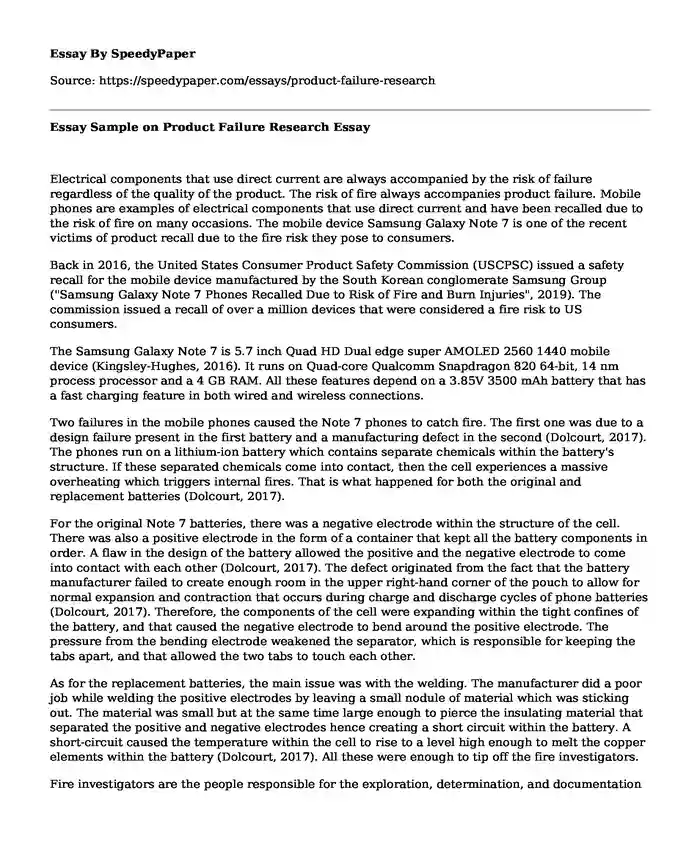
| Type of paper: | Research paper |
| Categories: | Research Branding Electronics Samsung |
| Pages: | 3 |
| Wordcount: | 696 words |
Electrical components that use direct current are always accompanied by the risk of failure regardless of the quality of the product. The risk of fire always accompanies product failure. Mobile phones are examples of electrical components that use direct current and have been recalled due to the risk of fire on many occasions. The mobile device Samsung Galaxy Note 7 is one of the recent victims of product recall due to the fire risk they pose to consumers.
Back in 2016, the United States Consumer Product Safety Commission (USCPSC) issued a safety recall for the mobile device manufactured by the South Korean conglomerate Samsung Group ("Samsung Galaxy Note 7 Phones Recalled Due to Risk of Fire and Burn Injuries", 2019). The commission issued a recall of over a million devices that were considered a fire risk to US consumers.
The Samsung Galaxy Note 7 is 5.7 inch Quad HD Dual edge super AMOLED 2560 1440 mobile device (Kingsley-Hughes, 2016). It runs on Quad-core Qualcomm Snapdragon 820 64-bit, 14 nm process processor and a 4 GB RAM. All these features depend on a 3.85V 3500 mAh battery that has a fast charging feature in both wired and wireless connections.
Two failures in the mobile phones caused the Note 7 phones to catch fire. The first one was due to a design failure present in the first battery and a manufacturing defect in the second (Dolcourt, 2017). The phones run on a lithium-ion battery which contains separate chemicals within the battery's structure. If these separated chemicals come into contact, then the cell experiences a massive overheating which triggers internal fires. That is what happened for both the original and replacement batteries (Dolcourt, 2017).
For the original Note 7 batteries, there was a negative electrode within the structure of the cell. There was also a positive electrode in the form of a container that kept all the battery components in order. A flaw in the design of the battery allowed the positive and the negative electrode to come into contact with each other (Dolcourt, 2017). The defect originated from the fact that the battery manufacturer failed to create enough room in the upper right-hand corner of the pouch to allow for normal expansion and contraction that occurs during charge and discharge cycles of phone batteries (Dolcourt, 2017). Therefore, the components of the cell were expanding within the tight confines of the battery, and that caused the negative electrode to bend around the positive electrode. The pressure from the bending electrode weakened the separator, which is responsible for keeping the tabs apart, and that allowed the two tabs to touch each other.
As for the replacement batteries, the main issue was with the welding. The manufacturer did a poor job while welding the positive electrodes by leaving a small nodule of material which was sticking out. The material was small but at the same time large enough to pierce the insulating material that separated the positive and negative electrodes hence creating a short circuit within the battery. A short-circuit caused the temperature within the cell to rise to a level high enough to melt the copper elements within the battery (Dolcourt, 2017). All these were enough to tip off the fire investigators.
Fire investigators are the people responsible for the exploration, determination, and documentation of the cause or origin of the fire. They identify the human actions that are responsible for the fire and become the authoritative voice in the courtroom in case of a conviction (Belfiglio, n.d). Fire investigators should report electrical failures and keep up with electrical components that have been recalled due to negligence or potential risk of failure as a precautionary measure to prevent the occurrence of future fires from the electrical component.
References
Belfiglio, G. (n.d.). How To Become A Fire Investigator. Retrieved June 16, 2019, from http://www.interfire.org/features/become_fire_investigator.asp
Dolcourt, J., (2017, April 17). Samsung Galaxy Note 7 recall: Everything you still need to know about what's coming next. Retrieved June 16, 2019, from https://www.cnet.com/news/samsung-galaxy-note-7-return-exchange-faq/
Kingsley-Hughes, A., (2016, August 02). Samsung Galaxy Note 7: Tech specs. Retrieved June 16, 2019, from https://www.zdnet.com/article/samsung-galaxy-note-7-tech-specs/
Samsung Galaxy Note 7 Phones Recalled Due to Risk of Fire and Burn Injuries. (2019, January 04). Retrieved June 16, 2019, from https://www.injurylawyer.com/product-recalls/samsung-galaxy-note-7-phones-recalled-due-risk-fire-burn-injuries/
Cite this page
Essay Sample on Product Failure Research. (2023, Jan 22). Retrieved from https://speedypaper.net/essays/product-failure-research
Request Removal
If you are the original author of this essay and no longer wish to have it published on the SpeedyPaper website, please click below to request its removal:
- Views on the Future of Robotics. Free Essay Example.
- Free Essay on the Needs of Users Using Online Locator Services
- Business and Law, Essay Example for Your Inspiration
- Free Essay on the Issue of Overcrowding in Criminal Justice Correction Facilities
- Essay Example on Chinese Social Cultural Issues and Regional Disparity
- Free Essay. Applied Behavioral Analysis in Public Schools
- The Goal of the Project. Essay Example
Popular categories




